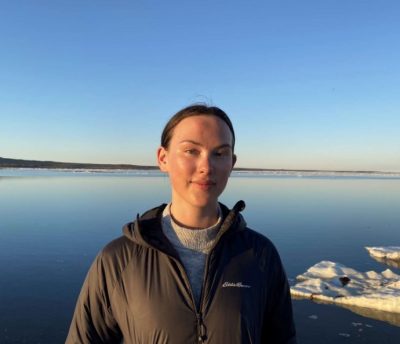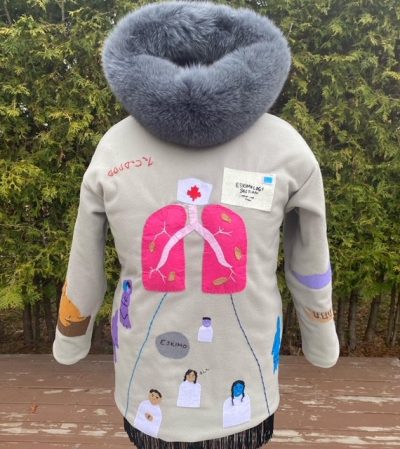By Jena Lynde-Smith
On Orange Shirt Day, Carleton University is committed to truth, conciliation and allyship.
From artistic expression to language, Carleton students are connecting to their history and culture. Continue reading to learn more about some of our inspiring students.
Augatnaaq Eccles Uses Sewing to Tell a Tragic Story in Inuit History
Augatnaaq Eccles combined her love of art and sewing with her passion for learning about Inuit history to create a parka like no other. The parka, which will be displayed at Parliament Hill on Sept. 30, tells the heartbreaking story of the Inuit experience with tuberculosis (TB) sanatoriums. In the mid-20th century, Inuit from communities across the North were forcibly transported south for treatment.

Augatnaaq Eccles
Eccles created the parka for a project in a course on the cultural history of diseases. She started her research reading letters by tuberculosis patients and was shocked to uncover letters from her own family members. The letters, which were translated to English for surveillance by the federal government of the time, spoke to both the hardship suffered in the facilities and the devastating separation of family members from one another.
“They were so worried about their family members that they were separated from. They didn’t know if their parents or if their kids were still alive,” Eccles says.
“The disruption that the TB sanatoriums had on Inuit communities was devastating, even after people returned home. Two, sometimes four, sometimes six years after they had been sent down south.”
Eccles moved to Ottawa in 2017 to attend Nunavut Sivuniksavut, a college program designed for Inuit youth, and joined Carleton’s history program the year after. With a deep interest in learning about her heritage, she takes every opportunity to explore and discuss Inuit history in her assignments.

Eccles’ parka will be displayed at Parliament Hill on Sept. 30.
“Studying history has really helped me to make more sense of where we are today, how we’ve gotten to this point, and how to move forward,” she says.
Before leaving her home in Rankin Inlet, Nunavut, Eccles wasn’t interested in sewing. It wasn’t until she became homesick for her community that she asked a friend to teach her.
“I was feeling so far from my culture, so sewing parkas was a way for me to practice my creativity and also feel close to home,” she says.
Sewing is an important part of Inuit tradition and has been passed on through generations of Inuit women. During their time in TB sanatoriums, many women, including Eccles’ grandmother, provided for themselves by selling their sewing.
Eccles continues to sew parkas and other clothing in her spare time. Earlier this year, she taught a sewing workshop for Inuit youth with Carleton’s Art Gallery and is set to teach another one in October during an Indigenous Women’s Arts Conference. After making its appearance at Parliament, Eccles’ commemorative parka will be displayed at the Canadian Museum of History from Oct. 14 to 16.
Find Eccles’ clothing shop, Augatnaaq’s Designs, on Facebook or Instagram.
Paula MacDonald Connects to Her Culture Through Indigenous Sign Language
In addition to her course studies Paula MacDonald, an Indigenous Studies student at Carleton, has used online resources and dictionaries to teach herself Plains Indian Sign Language (PISL), a language developed by Indigenous Peoples centuries ago.

Paula MacDonald
MacDonald, who is half Cree from Treaty 4, was born in Saskatchewan and adopted at a young age by a non-Indigenous family in Ottawa. Growing up deaf, she learned to communicate with American Sign Language (ASL). It wasn’t until she took a course on Native Americans in films at her former college that she began thinking about communication for Indigenous deaf peoples.
“Where is the Indigenous sign language?” asks MacDonald in an interview with the CBC.
Through investigation, MacDonald learned that for every Indigenous spoken language, there’s an equivalent Indigenous sign language. It was then that MacDonald decided she wanted to learn more about her culture.
“It really got the ball rolling for me, realizing that I can’t just say, ‘Hey, I’m Indigenous,’ and that’s it. I have to put in the work,” she says in a CBC video.
With very little public resources available on the subject, MacDonald bought a book and began teaching herself PISL. She also connected with fellow deaf Cree people who taught her some signs and found Marsha Ireland, a deaf Elder from the Oneida Nation near London, who developed her own sign language linked to her culture.
For MacDonald, learning PISL is important for many reasons — to connect to her culture, to be able to communicate with other deaf Indigenous people, but also to bring awareness to the colonization of Indigenous language.
“That is important for decolonization and for the ability to choose our language again,” says MacDonald.
Where ASL and LSQ where created by deaf people, for deaf people, PISL was devised by hearing Indigenous Peoples as a means to communicate across tribes that spoke different languages.
“Sign language is considered sacred,” says MacDonald. “It’s a limited resource used by a limited number of people.”
Its scarcity has made it hard for MacDonald to find a community of PISL speakers, but she hopes one day to attend a workshop in Western Canada — where most of those fluent in PISL reside — and to continue learning.
“We need to build relationships that allow us to engage and learn from each other.”
Friday, September 23, 2022 in Community, Indigenous
Share: Twitter, Facebook



